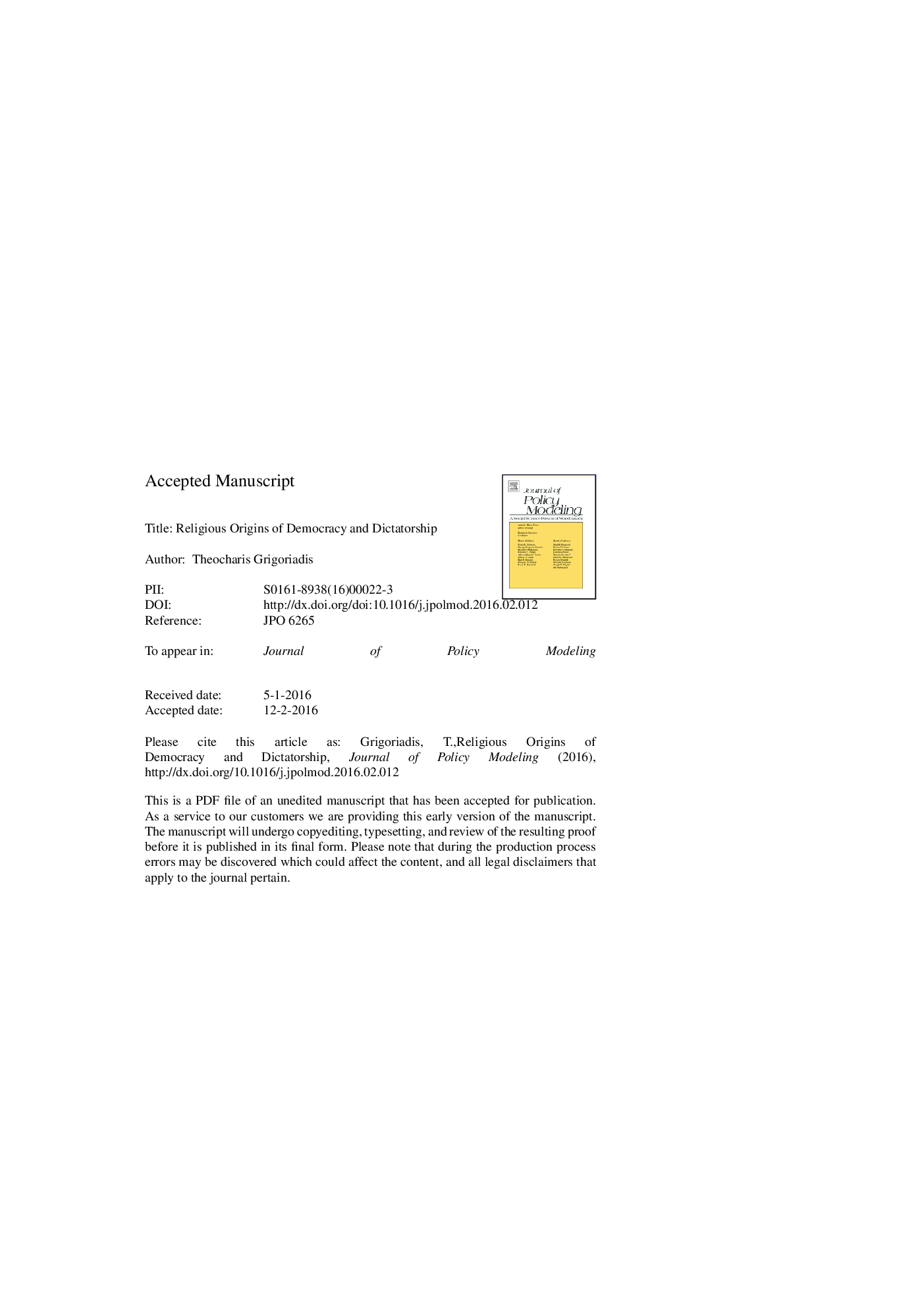| کد مقاله | کد نشریه | سال انتشار | مقاله انگلیسی | نسخه تمام متن |
|---|---|---|---|---|
| 5101706 | 1377317 | 2016 | 45 صفحه PDF | دانلود رایگان |
عنوان انگلیسی مقاله ISI
Religious origins of democracy & dictatorship
ترجمه فارسی عنوان
ریشه های مذهبی دموکراسی و دیکتاتوری
دانلود مقاله + سفارش ترجمه
دانلود مقاله ISI انگلیسی
رایگان برای ایرانیان
کلمات کلیدی
ترجمه چکیده
وبر اخلاق کار پروتستان را پایه و اساس سرمایه داری مدرن را مد نظر قرار داد. من ترویج نظریه وبر را با استدلال بر این می پندارم که ایالات با اکثریت کاتولیک رومی، ارتدوکس شرقی و جمعیت مسلمان، تمایل بیشتری نسبت به توسعه و دیکتاتوری نسبت به ایالت هایی با اکثریت پروتستان و یهودیان دارند. این مورد است، زیرا گروه های مذهبی مربوطه (صومعه، طارقا)، تسهیل سلسله مراتبی کالاهای مشترک را به هزینه مشوق های بازار ترویج می دهند. من مذاهب مذکور را به عنوان جمع گرایانه تعریف می کنم، در مقایسه با پروتستانتیسم و یهودیت، که من به عنوان فردگرایی تعریف می کنم. من یک نظریه تاریخی ارائه می دهم که کیبوت یهودی را به عنوان جمعی از دموکراسی و صومعه ارتدوکس شرقی به عنوان جمعی از دیکتاتوری تعیین می کند. تمرکز بر اقتصاد کالج گرایی، من متوجه می شوم که مدرنیزاسیون، به عنوان یک تعهد معتبر برای ارائه خدمات بهتر کالاهای عمومی، زمانی اتفاق می افتد که تهدید یک دولت رادیکال قریب الوقوع و زمانی که رهبر استخراج اجاره ها از اقتصاد بالا است. ظهور دولت های رادیکال در کالج گرایی بیشتر از اقتصادهای فردگرایان است. تصاویر تاریخی از اقتصاد کالج گرایانه شامل انقلاب روسیه، انقلاب اسلامی ایران و دولت رفاه پس از جنگ در اروپای غربی است.
موضوعات مرتبط
علوم انسانی و اجتماعی
اقتصاد، اقتصادسنجی و امور مالی
اقتصاد و اقتصادسنجی
چکیده انگلیسی
Weber considered the Protestant work ethic the foundation of modern capitalism. I extend Weber's theory by arguing that states with predominantly Roman Catholic, Eastern Orthodox, and Muslim populations have had a stronger inclination toward underdevelopment and dictatorship than states with Protestant or Jewish majorities. This is the case because their respective religious collectives (monastery, tariqa) promote the hierarchical provision of common goods at the expense of market incentives. I define the aforementioned three religions as collectivist, in contrast to Protestantism and Judaism, which I define as individualist. I provide a historical overview that designates the Jewish kibbutz as the collective of democracy and the Eastern Orthodox monastery as the collective of dictatorship. Focusing on collectivist economies, I find that modernization, as a credible commitment to the improved future provision of public goods, occurs when the threat of a radical government is imminent and when the leader has high extraction of rents from the economy. The emergence of radical governments is more likely in collectivist than in individualist economies. Historical illustrations from collectivist economies include the Russian Revolution, the Islamic Revolution in Iran, and the postwar welfare state in Western Europe.
ناشر
Database: Elsevier - ScienceDirect (ساینس دایرکت)
Journal: Journal of Policy Modeling - Volume 38, Issue 5, SeptemberâOctober 2016, Pages 785-809
Journal: Journal of Policy Modeling - Volume 38, Issue 5, SeptemberâOctober 2016, Pages 785-809
نویسندگان
Theocharis Grigoriadis,
